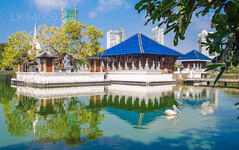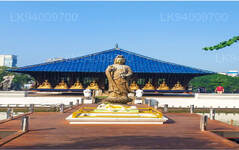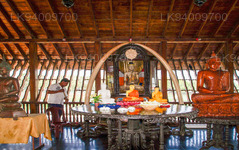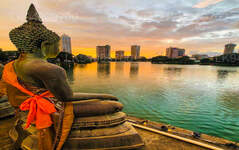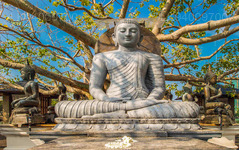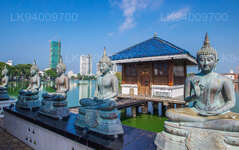
Colombo City
Colombo, the capital of Sri Lanka, is a dynamic city blending tradition and modernity. It showcases colonial architecture, lively markets, and serene Buddhist temples. With diverse cuisine, a growing skyline, and beautiful beaches, it's a vibrant hub for business, culture, and tourism, offering a gateway to explore Sri Lanka's wonders.
Seema Malaka
Within the heart of Colombo is the Gangarama Buddhist Temple. Built during the late 19th century for the Buddhists who lived in the capital city of Colombo; the temple sprawled over a large area of land and included several outer structures. The Seema Malaka is one of these. Originally, it was built with a foundation within the floor of Beira Lake, and was the image of stolidity. However, it was not able to withstand the marshy ground underneath the lake. By 1970 the Seema Malaka had sunk completely under the waters of Beira.
And then in 1976, Sir Geoffrey Bawa was hired to do this difficult construction design. He created three floating platforms interlinked by pontoon walkways and anchored to the base of the lake by way of stone pillars.
The light design ensured that the construction would not sink. The entire structure is connected to the shore using another pontoon bridge. He created a design that emulated the ancient monasteries of Anuradhapura and added his own signature modern twirl to it. Bawa was one of the most influential Asian architects of the mid to late 20th century and was well known for founding Tropical Modernism. This style is very apparent in the deep blue clay roof tiles of the main temple, the simplistic and yet delicate structure made of a collection of wooden spindles and banisters that lets plenty of air and light in, and the overall design that conforms to nature instead of fighting against it.Things to See
- The Central Platform: This platform has a number of Asian seated stone Buddhas along the perimeter of the platform. They are beautifully sculpted and come out well in photos. In the center is a room with slatted wooden walls. This comfortable place is used for meditation and yoga by visitors and devotees. It provides a relaxing view of the lake and its surroundings. It also has a beautiful large Buddha statue flanked by two giant elephant tusks. Before entering this room, you can take note of the Anuradhapura style dwarf guardian statues at the entrance; which are perfectly formed.
- The Northern Platform: This platform is sealed and is said to lead to the Treasury of the Truth. This houses a library of Buddhist texts and is only accessible by monks.
- The Courtyard: This is where the main part of Seema Malaka is. To one side of the courtyard, a comparatively small offshoot of the original sacred Bo tree in Anuradhapura grows out of a raised platform draped in prayer flags. It is flanked by Buddha statues of varied sizes – the biggest of which stands magnificently next to a small stupa. The courtyard has small rooms with wooden doors at the four corners. Within these are localized versions of Hindu Gods that the Buddhists worship as Devas. Just behind the main courtyard is a tier of stacked-up Buddha statues from Thailand. Close to this is the temple’s most surprising feature; a collection of vintage cars, presented by well-wishers over the years
- The Museum: On the way out of the entrance you can visit the museum. The temple museum has two big rooms overflowing with a treasure-trove of interesting objects; some collected for their symbolism, some for their artistic and/or financial value, and some just because. These include collections of ancient Sanskrit Ola leaf manuscripts, large sapphires and other precious stones, sandalwood and ivory carvings, brass statuettes of gods, jade & crystal monstrosities, elephant tusks, coins, innumerable Buddha images & statues of other Buddhist & Hindu deities, oil lamps, votive pagodas, old clocks, porcelain, ivory carvings, and even old gramophones. Overall they form what feels more like a cave of treasures that is definitely worth looking at.
About Colombo District
Colombo is the largest city and commercial capital of Sri Lanka. It is located on the west coast of the island and adjacent to Sri Jayewardenepura Kotte, the capital city of Sri Lanka. Colombo is a busy and vibrant city with a mixture of modern life and colonial buildings and ruins and a city population of 647,100.The Colombo Metropolitan Region, defined by the districts of Colombo, Gampaha and Kalutara, has an estimated population of 5,648,000, and covers an area of 3,694.20 km²
Colombo is a multi-ethnic, multi-cultural city. It is the most populous city in Sri Lanka, with 642,163 people living within the city limits. The population of Colombo is a mix of numerous ethnic groups, mainly Sinhalese, Moors and Tamils. There are also small communities of people with Chinese, Portuguese, Dutch, Malay and Indian origins living in the city, as well as numerous European expatriates.
The great majority of Sri Lankan corporations have their head offices in Colombo. Some of the industries include chemicals, textiles, glass, cement, leather goods, furniture, and jewellery. In the city center is located South Asia's second tallest building - The World Trade Centre.
About Western Province
The Western Province is the most densely populated province of Sri Lanka. It is home to the legislative capital Sri Jayawardenepura Kotte as well to Colombo, the nation's administrative and business center. Western Province is divided into 3 main districts called Colombo (642 km²), Gampaha (1,386.6 km²) and Kalutara (1,606 km²) districts. As Sri Lanka's economic hub, all the major local and international corporations have their presence in the city and so do all the major designer and high street retailers, so be ready to indulge in some retail therapy in western province.
Having the highest population in the all the provinces, the almost all the premier educational institutions in the island are located in western province. Universities in the province include the University of Colombo, the University of Sri Jayewardenepura, University of Kelaniya, Open University, Sri Lanka, Buddhist and Pali University of Sri Lanka, General Sir John Kotelawala Defence University and University of Moratuwa .Western province has the largest amount of schools in the country, which includes National, Provincial, Private and International schools.

